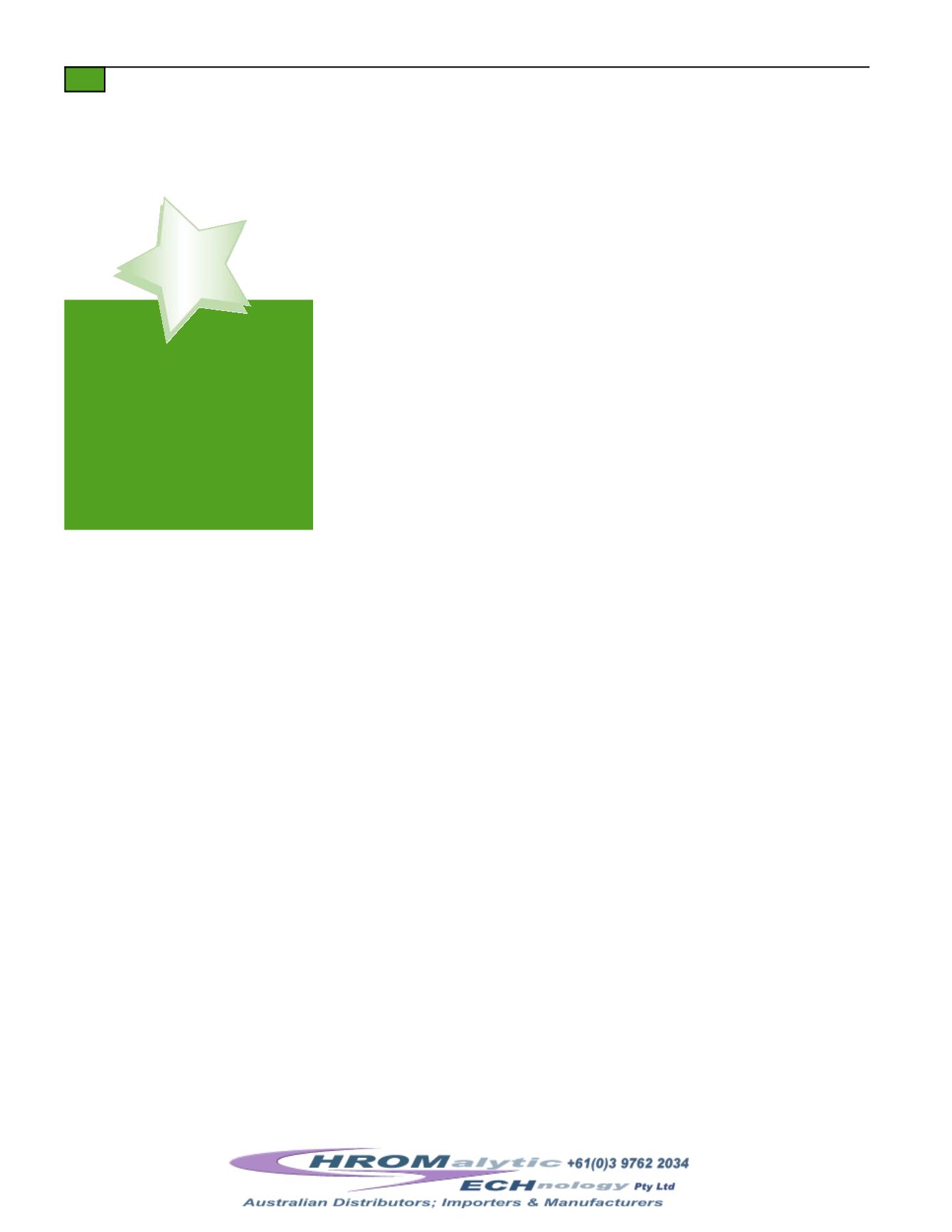
4
Automated liquid-liquid extraction
can rununattendedonce the samples are ready and the
solvent is added. This extraction is performed at a single pH.Generally, youwill need to
adjust the sample pH to2, but somemethods call for adjusting the pH to4. In any event, it is
critical tonot let the pHgobelow2whenusing a liquid-liquid extractor. If this happens, an
acidic extractwill form andmay cause damage to theGC column.Acidic extracts alsowill
cause low recoveries for the late-eluting internal standards, possiblydue to isotope exchange
(e.g., perylene-d12).
Automated liquid-liquid extractors are available in twoversions—conventional and acceler-
ated. The conventional types use 1Lof sample and extract using100 to500mLof
dichloromethane. These extractionvessels typically are operated for 16 to24hours inorder to
achieve complete extraction.The accelerated extractor uses ahydrophobicmembrane to
separate the aqueous from the organic phases, and the extraction time canbe reducedby25 to
30% compared to the conventional extractor.However, themembranes are expensive, so it is
important to analyze the cost versus the number of samples extracted todetermine if there is a
cost benefit tousing this accelerated technique.
Finally,
solidphase extraction
(SPE) alsomaybe used to extract semivolatile organic
compounds from aqueous samples.WhenusingSPE, it is extremely important to follow the
manufacturer’s recommendations for product use. There are severalmanufacturers ofC18
cartridges anddisks,which are the typicalmedia for these compounds. The specific steps to
extract these compoundswill vary somewhat dependingon themanufacturer.Oneof the
biggest problemswithSPE is pluggingof the diskor tubewith suspended solids, so this
methodonlyworks reliably for drinkingwater samples. If contamination levels are low and
the samples are free of solids, SPEprovides very fast extraction times and low solvent usage.
It is used easily for field extractions.And, generally, the disks are preferred for the extraction
of 1L sample volumes, but recoveries are not uniform for all of the compounds inTable I. The
compounds listed inUSEPAMethod525.2 exhibit good extraction recoveries using this
technique. For detailed informationon this extraction, request theApplicationsNote
“SPE
Extraction forUSEPAMethod525.1”
(lit. cat.#59557).
Soil Samples
Soxhlet andultrasonicextractionare themost commonextraction techniques for solid samples;
althoughpressurized fluid,microwave, and supercritical fluidextraction (SFE) alsocanbeused.
Because the soil andbiota samplesessentiallyarewet particles, acetoneanddichloromethane
(1:1) usuallyareusedas theextraction solvents.Acetone isneeded toadequatelypenetrate the
soil particle so that compounds in theparticlecanbeextracted. Several other solvent systems are
used formore specializedextractions, but formost applications this combinationworkswell.
All solvents used for extractionsmust beACSpesticide-residue grade, and a solvent assay
shouldbe performed toverifypurityprior touse. Toperform a solvent assay, evaporate 300 to
400mLof solvent to a final volume of 1mLand analyze byGC/mass spectrometry (MS). The
resulting chromatogram shouldhaveno compounds quantitated above
1
/
2
thedetection limit
for any target compound.
Soxhlet andultrasonicextraction
workwell for the semivolatilecompounds listed inTable I.
Sonication is a faster techniquebut requires constant operator attention. Inboth techniques,
problems usually are causedby contaminated reagents (especially sodium sulfate) or by
inconsistent handling from sample to sample. Sodium sulfatemust be treated to removewater
as described in theRestekTiponpage 3, and the samplemust bemixedwith the sodium
sulfate to achieve a sandy consistency.
Pressurized fluid extraction
(USEPAMethod3545A) canbe run in anunattended fashion
withmultiple samples across awide sample size range. Extractionvesselswithvolumes of 1
to100mLare available. Instruments like theDionexASE200 accommodatewet samples
from1 to15grams, and theDionexASE300will accommodatewet samples from15 to50
grams. The volume of the cell needed forwet samples is generally twice the gramweight of
the samplebeingused. For example, if 30-gwet samples areneeded, the66-mL and100-mL
vesselswill be adequate for these extractions. This is necessarybecause a drying agent such
Restek
Tip
CleanGlassware
It is important toproperly clean
glasswareusedduring sample
extraction.Contaminatedglass
surfaces can reactwith samples and
causebreakdownor adsorptionof
activecompounds.Verifycleanliness
by runningblanks through all
glassware.
Website :
E-mail :
TelNo : 03 9762 2034 . . . inAUSTRALIA


